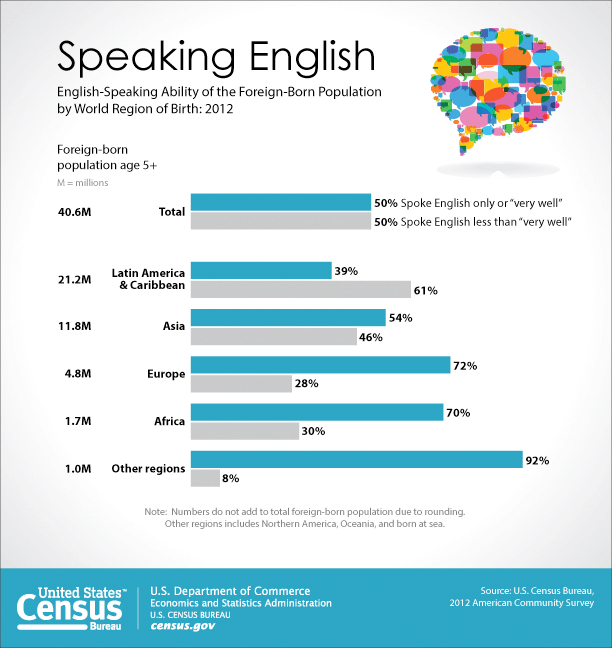Close to Half of New Immigrants report High English-Language Speaking Ability [REPORT]
June 11, 2014
![]() A new report, English-Speaking Ability of the Foreign-Born Population in the United States: 2012, uses statistics from the Census Bureau’s American Community Survey to focus on the relationships between English-speaking ability and place of birth, level of education and years spent living in the United States.
A new report, English-Speaking Ability of the Foreign-Born Population in the United States: 2012, uses statistics from the Census Bureau’s American Community Survey to focus on the relationships between English-speaking ability and place of birth, level of education and years spent living in the United States.
 “In general, people who migrated to the United States a long time ago speak English better today than those who migrated recently, and those with more education have higher English-speaking ability than those with less education,” said demographer Christine Gambino of the Census Bureau’s Foreign-Born Population Branch, one of the report’s authors. “This association between time in the United States and educational attainment is seen whether immigrants are from Africa, Asia, Europe and Latin America or the Caribbean.”
“In general, people who migrated to the United States a long time ago speak English better today than those who migrated recently, and those with more education have higher English-speaking ability than those with less education,” said demographer Christine Gambino of the Census Bureau’s Foreign-Born Population Branch, one of the report’s authors. “This association between time in the United States and educational attainment is seen whether immigrants are from Africa, Asia, Europe and Latin America or the Caribbean.”
Almost three-fourths (73 percent) of the foreign-born age 25 and over with a bachelor’s degree or higher had high English-speaking ability, speaking only English at home or speaking another language at home and speaking English “very well.” The same was true for only 19 percent who had less than a high school education.
The English-speaking ability of the foreign-born does vary geographically. The proportion of foreign-born age 5 and older speaking a language other than English at home was higher in California, Illinois, Nebraska, Nevada, New Mexico, and Texas, at about nine in 10, compared with 85 percent nationally. Furthermore, in all of these states except Nevada, a majority of the foreign-born spoke English less than “very well” (that is, “well,” “not well,” or “not at all”). For example, 59 percent of the foreign-born in Texas and 57 percent in California spoke English less than “very well,” compared with 50 percent nationwide.
Other highlights:
· Among the nearly 41 million foreign-born 5 and older residing in the United States, 15 percent spoke only English at home. More than one-third (35 percent) spoke a non-English language at home and also spoke English “very well,” resulting in about half of the foreign-born having high English-speaking ability.
· Over time, the foreign-born have become more likely to speak a language other than English at home, with this percentage rising from 70 percent in 1980 (among those 5 and older) to 79 percent in 1990, 83 percent in 2000 and 85 percent in 2012.
· New Hampshire and the District of Columbia had among the lowest proportions who spoke English less than “very well” (both about 30 percent) among states or equivalents with a foreign-born population age 5 and older of 50,000 or more.
· The foreign-born age 5 and over from Canada, Germany, Jamaica and the United Kingdom were comprised almost entirely of those with high English-speaking ability. Furthermore, the majority of those from India and the Philippines, where English is widely used as an official language, had high English-speaking ability (74 percent and 70 percent, respectively).
· More than half of the foreign-born age 5 and over from Mexico, China, El Salvador, Vietnam, Cuba and Korea spoke English less than “very well.” Each of these countries contributed at least 1 million foreign-born residents.
To view report CLICK HERE.




























